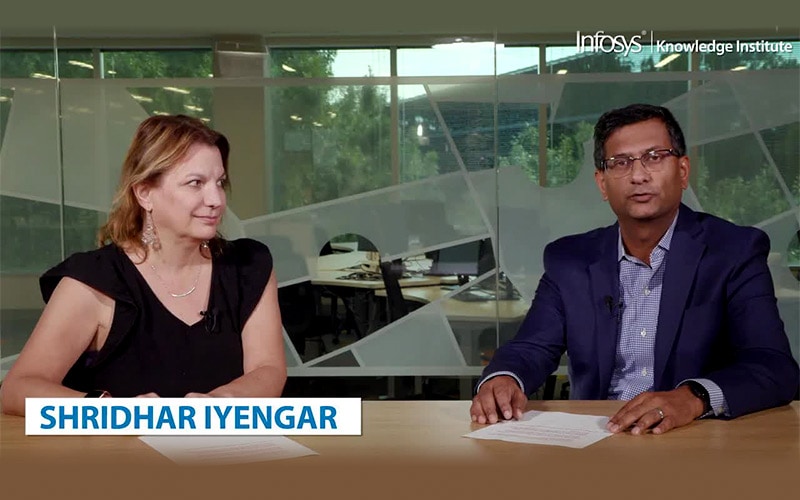Insights
- While Agile and DevOps have become the de-facto way of going digital, the adoption varies in terms of scale and maturity across organizations.
- And although many reap IT benefits of velocity, deployment frequency, and MTTR, only a few translate these into business growth, customer satisfaction, and market differentiation.
- Operating models need to evolve significantly for enterprises to thrive in the digital future. The core construct is customer-centricity, product (not project) thinking, integrated teams, a culture of experimentation and innovation, and value measurement.
- Organizations should adopt a six-component framework to evolve to a future-ready operating model. While each component generates business benefits, true business agility requires an initial focus on customer journeys and product thinking before talent, platforms, and governance.
- Many firms we’ve worked with are instituting this new product- and platform-based operating model. This shift to product-centric value delivery to drive digital journeys can deliver significant results, as early as within 18 months.
While Agile and DevOps have become the de-facto way of going digital, the adoption varies in terms of scale and maturity across organizations. Although many reap IT benefits of velocity, deployment frequency, and mean-time-to-recover (MTTR), only a few translate these into business growth, customer satisfaction, and market differentiation.
The problem with existing ways
Lack of alignment to customer needs, exacerbated by fragmented value chains and functional siloes, impedes operating model objectives like idea generation and collaboration. Further, business and technology are often not in the same room, limiting innovation.
Operating models need to evolve significantly for enterprises to thrive in the digital future. The core construct is customer-centricity, product (not project) thinking, integrated teams, a culture of experimentation and innovation, and value measurement. Agile, DevSecOps and site reliability engineering (SRE) provide the foundation and rhythm.
Operating model transformation makes firms future-focused and effective, while sustaining momentum in their digital journeys.
Reorganize to deliver value
The future operating model has the agility of a startup; is responsive to customer needs; is networked and connected; maintains velocity of ideas and innovations; finds competitive advantage through platforms; and uses extreme automation in everything it does. The focus on flow of value brings about reorganization of organizational structures and processes with an emphasis on user journeys, value streams, and product-centric autonomous teams.
Framework in action
A successful operating model transforms a slow-moving incumbent into an innovative, customer-centric, and resilient digital enterprise.
How?
Organizations adopt a six-component framework to evolve to a future-ready operating model (Figure 1).
Figure 1. Six-component framework for future-ready operating model

Source: Infosys
While each component generates business benefits, true business agility requires an initial focus on customer journeys and product thinking before talent, platforms, and governance. Mature digital superstars such as Tesla, Netflix, and Haier embed each lever in their operations, and their success stories say much.
Reimagine journeys
Organizations seeking to focus on their customers typically start by mapping customer journeys and associated value streams (a significant growth lever in Agile Radar 2021 analysis). This is the most effective collaborative exercise to blend the end-user perspective with all value stream functions. It breaks down internal silos within organizations and aligns with customer needs. Further, expert experience designers can help firms reimagine digitization journeys to amplify customer experience.
Embrace product thinking
If Agile is the vehicle, product thinking is the GPS system to ensure firms are driving in the right direction. Product thinking enables employees to move in lockstep with market and customer demands, whether it is a service, capability, or consumer product. Industry-specific product taxonomy breaks down customer journeys and associated value streams into autonomous capabilities, constituting products. These products then become the cornerstone of the product-centric operating model.
Product management helps translate organizational vision and strategy into tangible roadmaps, backlogs, and key performance indicators (KPIs), leading to better business outcomes.
Product management leads to better business outcomes by translating vision and strategy into roadmaps, backlogs, and KPIs
Agile Radar 2021 research found product management as the highest business and IT investment.1 Further, 85% of firms look to inculcate product-centric delivery models in short to medium term.2
Product thinking should permeate to the team level to instil innovation and experimentation within organizations — learning by doing rather than by classroom training. Hackathons can be a good channel to fuel this thinking. Culture and mindset change is key to success, with leaders providing visible commitment and sponsorship and leading this change by walking the talk. Two-thirds of Agile Radar research respondents identified culture and mindset as the biggest challenges to implementing Agile. Yet, only 32% of business executives listed driving cultural change as a top investment priority, and only 24% of CIOs did the same.3
Align talent to the flow of value
Cross-functional collaboration boosts productivity and creativity. Companies that effectively collaborate across functional boundaries realize faster growth.4
Concentration on customer journeys, value streams, and products unites business and IT teams in an autonomous product team construct. Such integrated teams are true Dev and Ops teams that take end-to-end ownership through the product lifecycle. Product teams comprising one or more pods typically possess full-stack engineering capabilities.
A leading logistics client established a product-based organizational construct, through more than 40 Agile pods with engineering and product management capabilities. These autonomous teams showed high responsiveness to customer feedback, enhancing experience, profitability, and shareholder value.5
Sourcing composition has also changed with increased demand for niche capabilities (expertise in low code platforms, data engineering and visualization etc.) and decentralized workforce structure. With the dearth of talent to meet this demand, outsourcing partners, contractors, gig workers, and even AI coworkers have become a part of the supply chain. CIOs seek partners who can take joint accountability in the transformation journey instead of command-and-control structures of the past. Businesses also have a bigger role in partner selection and onboarding. Integrating the changed workforce composition is an essential element of future engagement models.
Embed agility and sentience in the value stream
Agile and DevSecOps are the foundation for effective product-centric value delivery. Advanced analytics on the underlying data from Agile-DevSecOps toolchains help derive insights, track the flow of value, drive decisions, and enhance predictability. Also, SRE practices ensure continuous observability across the value stream.
Most enterprises have a disparate technology landscape, comprising legacy, custom-off-the-shelf, digital, and cloud technologies. Leveraging Agile and DevSecOps principles help achieve synergy and agility. However, the current reality is multispeed IT with ‘agile’ digital and ‘waterfall’ legacy as a duality from opposite ends of the scale. In the short term, organizations should start this journey by aligning product backlogs, release plans, and associated workflows.
Platformize the ecosystem
Core capabilities integrated as platforms result in faster product launches, more innovations, and system stability. These can manifest as business platforms and/or common capabilities (IT infrastructure/data, etc.) consumed by product teams.
Business platforms for products and services can fast-track concept-to-cash. The producer-consumer ecosystem generates innovative business models and services. These platforms create new services, and increase speed, efficiencies, and scale.
A large transportation company, in association with Infosys, built a digital freight marketplace. This platform acted as a foundation for rapid product development — across retail customer, carrier, and freight operator personas. Products included track consignments, pricing, and ‘best route’ optimizations, delivering significant business value for all parties.
Core IT infrastructure and common services platforms accelerate delivery and modernize the tech landscape for digital (cloud, microservices, and data), drive adoption of enterprise technology stacks, and ensure system stability. For example, at Google, if a team works on an enterprise search product that can filter searches by available inventory, the common services inventory-platform team might build an API that allows product teams to query inventory data for in-stock items. At Code for America, automating the clearance process for eligible detainees involves a cloud and AI infrastructure services team that continuously streamlines its work and that of the wider technology organization.
Finally, enabler teams for shared services, such as centers of excellence and community of practices, bolster advanced capabilities in product and platform teams at optimized costs. These practices reduce the strain on a member solely working on a product, reducing the risk of burn-out in an ambitious sprint cycle.
Govern on value
With clarity on how value is delivered, it is equally important to consistently measure value as it applies to markets, customers, and employees.
Firms like Google and Intel, and even non-profit firms like Code for America, use the objectives and key results (OKRs) methodology to map high-level strategy to initiatives and goals. Objectives are aggressive, yet doable. Executives and practitioners build objectives to create accountability across teams. Objectives are the “whats” of the transformation, and key results are the “hows”.
Code for America’s main objective was to use technology to clear all eligible records of those with a criminal past.
The key results?
In the first stage, 10,000 people connected with lawyers to prepare clearance paperwork and submit it to courts. This vision set the tone for small product teams to unite around technology, igniting innovation.
In a product-centric operating model, OKRs align to business objectives and are further translated to key product KPIs. This alignment helps the team focus on outcomes, without losing the flexibility to manage their backlogs and roadmaps. An OKR framework helped a leading global bank transform to lean portfolio management centered around value streams and agile funding.
OKRs create accountability across teams. Objectives are the “whats” of the transformation, whereas key results are the “hows”
Value measurement also influences decisions on financial priorities, from initiative funding to team incentives. Integrating “change” and “run” budgets to cater to a common backlog provides greater clarity on investments within value streams. A minimum viable product is an ideal vehicle for short cycle funding decisions, providing a view into potential outcomes and opportunities for course correction. Team incentives also bring greater ownership.
Moving ahead
Many firms we’ve worked with are instituting this new product- and platform-based operating model. A leading European telco is integrating its business and technology teams to create a one-team customer-focused construct. This way, the firm responds quickly to market changes and launches products faster. At another leading financial services organization in the U.S., where Infosys is leading a tech-led business transformation, there has been a pivot from a functional, siloed structure to a customer journey-led construct. With integrated product teams aligned to these journeys, the organization has a direct line of sight to business value.
This shift to product-centric value delivery to drive digital journey can deliver significant results, as early as within 18 months. Though there is no end state as such, the north star on this multiyear, complex journey is to become a “live enterprise”,6 which is at once fluid, dynamic, and product- and customer-centric. So, get the model right, start small, be bold, and think and act like a digital native.
References
- Agile Radar 2021, IKI.
- Gartner survey finds 85 percent of organizations favor a product-centric application delivery model, February 19, 2019, Gartner.
- Agile Radar 2021.
- Agile Radar 2021.
- Agile Radar 2021.
- The Live Enterprise: Create a Continuously Evolving and Learning Organization, Jeff Kavanaugh and Rafee Tarafdar, January 26, 2021, McGraw Hill.





